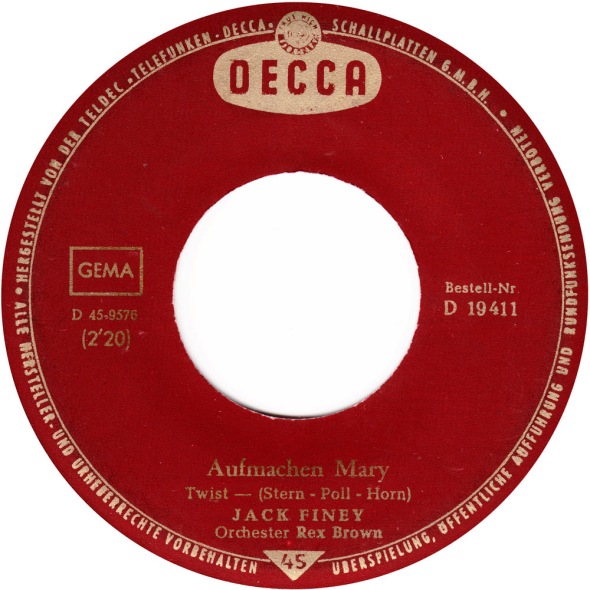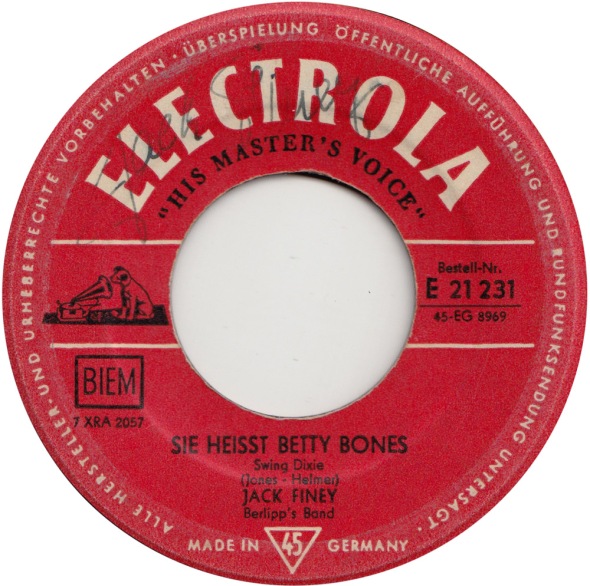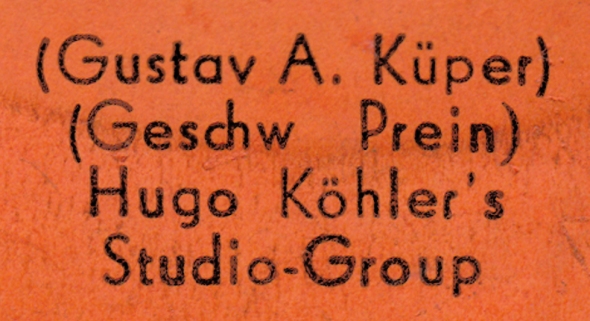KRESSBRONNER DORFMUSIKANTEN, Gewitter-Boogie
Posted: November 30, 2014 Filed under: 60s, Germany, Instrumental Records Leave a comment


 The Kressbronner Dorfmusikanten, a brass band from the village of Kressbronn, were “Kressbronns fröhlicher Exportartikel”, their jolly export item. Kressbronn is located way down in the south of Baden-Württemberg, on the edge of Lake Constance.
The Kressbronner Dorfmusikanten, a brass band from the village of Kressbronn, were “Kressbronns fröhlicher Exportartikel”, their jolly export item. Kressbronn is located way down in the south of Baden-Württemberg, on the edge of Lake Constance.
Initially formed for an appearance at the 1964 Berlin International Green Week, the group stayed together for 16 years.
Gewitter is thunder storm. Thunder Storm Boogie…
KRESSBRONNER DORFMUSIKANTEN, Gewitter-Boogie
IVOR MAIRANTS SEPTET, Toot De Toot, 1959
Posted: November 28, 2014 Filed under: 60s, England, Instrumental Records Leave a comment


 The electric guitar is the most important instrument in pop music of the second half of the 20th century. Still, most guitarists remained music-workers that kept in the shadow of the stars they accompanied. Few of them managed to become stars themselves. So far, I´ve done small portraits of session guitarists like George Barnes, Everett Barksdale, Grady Martin, and German guitarists Dieter Resch and Fritz Woelffer.
The electric guitar is the most important instrument in pop music of the second half of the 20th century. Still, most guitarists remained music-workers that kept in the shadow of the stars they accompanied. Few of them managed to become stars themselves. So far, I´ve done small portraits of session guitarists like George Barnes, Everett Barksdale, Grady Martin, and German guitarists Dieter Resch and Fritz Woelffer.
Ivor Mairants (1908-1998) was a very prolific British guitarist from the 30s to the 70s. He wrote influential guitar instruction books and in 1958, opened Britain’s first specialist guitar shop. It still exists today.
Some examples of his guitar work can be heard on Youtube. A British Pathé film from 1933 shows a young Ivor Mairants playing guitar and singing with a trio, in the Roy Fox Band. The band appears in the last 3 minutes. In 1942 he played with Jack Simpson and his Sextette. Mairants guitar can be heard in the brilliant Stay Out Of The South featuring vocalist Betty Kent.
Despite his prolific careeer and legacy, Ivor Mairants solo work has not been reissued in more than 50 years. That includes an album by Ivor Mairants and his Septet on the British Richmond label and this EP on the Dutch Palette label.
Ivor Mairants versatile guitar work deserves to be heard again, whether it be in the swingin´Toot De Toot, originally written by Belgian jazz musician Toots Tielemanns, or the rockin´Asia Minor, clearly inflenced by Les Paul.
IVOR MAIRANTS SEPTET, Toot De Toot, 1959
IVOR MAIRANTS SEPTET, Asia Minor, 1959
IVOR MAIRANTS SEPTET, Vira Vira, 1959
IVOR MAIRANTS SEPTET, El Patito, 1959
FRITZ WOELFFER AND HIS GUITAR, Indio/ County, 1969
Posted: November 19, 2014 Filed under: 60s, Germany, Instrumental Records 5 Comments


 In April 2008, six month after I had started Berlin Beatet Bestes, I posted this 45 by Fritz Woelffer for the first time. I wrote: “The two songs are solid instrumental Rock´n´Roll in the European Easy-Listening style of the Spotnicks, the Shadows or Jorgen Ingmann. Sadly, the first 10 seconds of Indio are pretty scratched up, to the point of being unlistenable. I`m putting the song here anyway. Until I find a better copy…”
In April 2008, six month after I had started Berlin Beatet Bestes, I posted this 45 by Fritz Woelffer for the first time. I wrote: “The two songs are solid instrumental Rock´n´Roll in the European Easy-Listening style of the Spotnicks, the Shadows or Jorgen Ingmann. Sadly, the first 10 seconds of Indio are pretty scratched up, to the point of being unlistenable. I`m putting the song here anyway. Until I find a better copy…”
I actually never expected to see another copy. Not that the record is particularly sought after, but it´s rare and just never turns up. Well, last week I finally found one, at a Berlin record fair. Ironically, it was the first record I picked, when I absent-mindedly let my hand wander through a box of cheapo 45s. Usually I never bother with cheap records at record fairs, because there is too much high quality stuff to choose from already. Even though I had never seen the sleeve, I recognized the record immediately. It looks like it´s never been played and the sleeve is in good condition too. I paid 1 Euro.
Only a handful of German guitarists like Ladi Geisler, Coco Schumann, Dieter Resch, played this style in the 1960s. None of them ever made it big. On top of that, Fritz Woelffer´s Date 45 unfortunately fell out of time. Instrumental rock was long out of style, when it came out. Contrary to what I assumed six years ago, the record is not from the early, but from the late 60s. Both songs seem perfect. Indio is a seamless Western-movie themed tune. County is a sweet little tune, that apart from what the title suggests, also features bass, organ and drums. But it was all in vain. The odd sleeve probably didn´t help sales either. Fritz Woelffers only solo record went completely under the radar.
Fritz Woelffer was a well-known local session musician. In the late 40s he played guitar with the Heinz Becker Barquintet and recorded a bunch of sided for Amiga. So Woelffer was from Berlin, but I´m not so sure, that these songs were recorded in Berlin any more. The record was published by Albert Bennefeld out of Berlin-Schlachtensee, but the back of the sleeve lists one Hermann Will (date-Tonproduktion für Schallplatte, Funk und Fernsehen, 8662 Helmbrechts), as the producer. So the date label was obviously from the small town of Helmbrechts, in the Upper Franconia region in the state of Bavaria.
My first copy of this record was so scratchy, that I didn´t even notice it was in stereo and recorded it in mono. Now, I re-recorded both sides in glorious stereo.
Enjoy!
FRITZ WOELFFER AND HIS GUITAR, Indio, 1969
FRITZ WOELFFER AND HIS GUITAR, County, 1969
The date label apparently issued mainly Bavarian folk music from the region, but then suddenly changed to beat and pop in the late 60s. Most notably Günter Noris, who became famous as leader of the Big Band of the German Bundeswehr. I have never seen, nor heard any of these other Date records:
– 1016 Günter Noris und sein Orchester, Playboy-Slop/ Hurrikan
Eine Instrumentalplatte mit viel Sound und Schwung. Ideale Party-Platte
– 1017 The Sunsets, Believe it everyday/ Blared Black Beat
Das Richtige für verliebte Leute – Soft Beat (weicher Beat)
– 1018 Orchester Ralf Cardello, Play Beat/ Canadian Patrol
Big Band Beat – Eine Sensation
– 1019 Fritz Woelffer and his Guitar, Indio/ County
—————————————————————————-
(Über Fritz Wölffer habe ich auch in meiner wöchentlichen Kolumne Berlin Beatet Bestes in der Jungle World Nr. 47 vom 20. November 2014 geschrieben.)
MAMBO BAND, Hey-O-Mambo, 1966
Posted: November 16, 2014 Filed under: 60s, Beat Records, Germany 2 Comments
 When I arrived at the flea market on Saturday, it was already afternoon. Not too many people strolled around the flea market in the icy wind, but nevertheless most of the boxes had probably been combed through by other collectors. One of the first booths I went to, belonged to a nice lady my age, a seasoned seller, who comes to the flea market even when it´s snowing. Now she was sneezing and coughing. I noticed that two guys were checking through the pile that I had just picked and told them kindly:” I just picked those.” One guy replied, “Oh! Sorry. I´m still curious what you found. Mind if I take a look?” I said: “You´re welcome. Go ahead.”
When I arrived at the flea market on Saturday, it was already afternoon. Not too many people strolled around the flea market in the icy wind, but nevertheless most of the boxes had probably been combed through by other collectors. One of the first booths I went to, belonged to a nice lady my age, a seasoned seller, who comes to the flea market even when it´s snowing. Now she was sneezing and coughing. I noticed that two guys were checking through the pile that I had just picked and told them kindly:” I just picked those.” One guy replied, “Oh! Sorry. I´m still curious what you found. Mind if I take a look?” I said: “You´re welcome. Go ahead.”
Well, they both saw this 45 and didn´t bat an eyelash. We talked about another one in the pile, a Spanish opera record that had a cowboy on the sleeve. I ended up not buying it. But, without knowing what it was, I did buy the Mambo Band for 1 Euro. No wonder this unassuming, sleeveless 45 went by unnoticed. Most collectors don´t go for mambo.
Well, as it turned out, Hey-O-Mambo is a great garage beat rocker, fuzz guitar and all…
When I heard Hey-o-Mambo at home for the first time, I immediately checked the Internet. It´s been featured on Prae-kraut Pandaemonium #14, that came out in 2003, the same Volume that also has Andy Nevison & His Rhythm-Masters White Woman.
This is what Peter Urbach wrote, in the trademark hip PKP-style liner notes: “Though credited on their Etzel 7” as Mambo Band, these guys were better known as The Mambos all over the Lower Franconian hinterland. A rare case of early German frat rock, these kids looked like acolytes on a joyride, but could do a neat Sonics imitation, when fuelled with enough homebrew. Remember: There’s nothing dirty about sax, except you know how to blow right…”
Left out from Bear Family Records huge German Beat round-up “Smash!…Boom!…Bang!…”, it´s due to the classic Prae-kraut series, that bands like the Mambos were finally put on the global map of Rock´n´Roll. Of course, it also led to increase the value of the original 45s.
Apart from the bootleg PKP re-issue, that is sold out, the songs are currently not available anywhere.
Rock´n´Roll-wise, there is nothing more to add. Still, the flip sheds a little more light on the background of the Mambo Band.
MAMBO BAND, Geh´ nie mehr fort von mir, 1966
Started as a duo by Kurt Eisemann (organ) and Hilmar Hirt (sax) in 1952, when the Mambo was in style, they soon developed into a full band. After more than 60 years, they still play locally.
JACK FINEY, Aufmachen Mary, 1961
Posted: November 10, 2014 Filed under: 60s, Germany, Twist Records Leave a comment
 Jack Finey is a really great and underrated artist. Unfortunately, these two 45s are the only records of his, that I own. I´d sure like listen to some of his other sides, like Das ist fies Luise or Shake it Nelly Grey. I bet they´re great too! Apart from Schade um die Rosen, none of his songs have ever been re-issued, so they´re not available on Itunes, Amazon, Spotify, not even Youtube. Please, can somebody help with some more Jack Finey?
Jack Finey is a really great and underrated artist. Unfortunately, these two 45s are the only records of his, that I own. I´d sure like listen to some of his other sides, like Das ist fies Luise or Shake it Nelly Grey. I bet they´re great too! Apart from Schade um die Rosen, none of his songs have ever been re-issued, so they´re not available on Itunes, Amazon, Spotify, not even Youtube. Please, can somebody help with some more Jack Finey?
Jack Finey recorded at least 14 sides until 1967. This is a list of his recordings, compiled by Deutsches Rock´n´Roll Schallplattenforum:
– Oh Baby, Komm’ Sofort Nach Haus’ (Baby, Won’t You Please Come Home)/Die Kaltmamsell Vom Grand-Hotel (Decca 19370) 1960
– Evelyn/Aufmachen Mary (Decca 19411) 1961
– Die Geschichte Von Stagger Lee (Stagger Lee)/Sie Heißt Betty Bones (Electrola 21231) 1959
– Piccola/ Schade Um Die Rosen (Electrola 21390) 1960
– Das Ist Fies Luise/ Genau (Electrola 21554) 1961
– Du Kleines Gör (In Der Badewanne)/Boing (Amadeo AVRS 21237) 1962
– Yes Tonight Josephine/Shake It Nelly Grey (Vogue DV 14594) 1967
Aufmachen Mary is a great nutty Twist!
JACK FINEY, Aufmachen Mary, 1961
JACK FINEY, Sie heisst Betty Bones, 1959
Posted: November 4, 2014 Filed under: 50s, Germany, Rock´n´Roll Records 6 Comments
 The story of Afro-Caribbean artists working in Germany in the 1950s, has not been written yet. After the second World War, musicians like Roberto Blanco (Cuba), Mona Baptiste (Trinidad), Billy Mo (Trinidad) and Jack Finey (Curaçao) helped to transform German culture and society. From a despised and isolated country, that had caused the worst crimes of the century, back into the civilized world. Germans simply couldn´t have lifted themselves out of their misery. As you will hear, they needed the help of some spirited Caribbeans desperately.
The story of Afro-Caribbean artists working in Germany in the 1950s, has not been written yet. After the second World War, musicians like Roberto Blanco (Cuba), Mona Baptiste (Trinidad), Billy Mo (Trinidad) and Jack Finey (Curaçao) helped to transform German culture and society. From a despised and isolated country, that had caused the worst crimes of the century, back into the civilized world. Germans simply couldn´t have lifted themselves out of their misery. As you will hear, they needed the help of some spirited Caribbeans desperately.
Unfortunately, information about Jack Finey is scarce. At least, the trusty German Rock´n´Roll-Schallplattenforum, collected a bit:
Jack Finey (born Jakob Frerian Christian Schreuder) was born in Amsterdam in 1928. He grew up in Curaçao and returned to Amsterdam when he was 14 years old. He appeared on Broadway. In 1959 he first recorded in Germany for Electrola and later Decca, also for the Austrian Amadeo label in 1962 and for German Vogue label in 1967. In 1960 Jack Finey appeared in the German musical comedy “Meine Nichte tut das nicht” with his song Schade um die Rosen.
In 1959 Jack Finey recorded this fine two-sider for Electrola, containing German versions of Louis Prima´s “The Closer To The Meat” and Lloyd Price´s “Stagger Lee”.
Like other popular American folk songs, such as Delia Gone, Stagger Lee is a song about an actual murder case. In 1895, “Stag” Lee Shelton, a black pimp, shot Billy Lyons in St. Louis, Missouri, over an argument about politics. Lyons snatched Shelton´s hat from his head. Stagger Lee demanded it back. When Billy refused, Stagger Lee shot him, took his hat and walked away. Shelton was arrested and convicted of murder in 1897. The crime quickly entered into American folklore and became the subject of songs.
In 1928, Mississippi John Hurt recorded the most well-known blues version of Stagger Lee. Twenty-two years later, New Orleans rhythm & blues pianist Archibald wrote and recorded his own version of Stack A Lee. It´s a New Orleans boogie in an easygoing, rocksteady rhythm, that is very well worth listening to on Youtube. The Imperial 45 has two parts. In Part 2, Stagger Lee dies and goes to the devil. Lloyd Price covered Archibald´s “Stagger Lee Part 1” and turned it into a # 1 hit on the Billboard charts in 1959.
Whereas the lyrics of German versions of US hits were usually changed completely, and left only the melody intact, the German lyrics to “Stagger Lee” are unusually faithful to the original. They´ve got pretty much the exact meaning and content, down to naming the song ” Die Geschichte von Stagger Lee” (The story of Stagger Lee). The German writer Nicolas sure had a good instinct for teenage subjects. Whereas Dick Clark reportedly had Lloyd Price change the lyrics to a fight over a woman and a happy ending, to appear on his show, the German lyrics keep the bloody ending.
Just for comparison, I transcribed the lyrics. The lines change from German to English, to make the song more authentic. Note the Dutch accent in “He´s real danger!”:
“Ich stand müde an der Ecke,/ doch ich bin dann plötzlich aufgewacht./Auf der Strasse würfelten zwei Männer in der Nacht./ Da war Stagger Lee, da Billy,/ da die Würfel, um Mitternacht./ Stagger Lee warf eine Sieben,/ Billy schwor, er habe acht./ Stagger Lee sagte heiser,/ lass das Zeug , Mensch. Ich habe ´ne Wut./ Du hast all mein Geld gewonnen/ und auch meinen neuen Hut./ Stagger Lee ging nach Hause,/ schob ´ne Kugel in den Lauf./ Sagt, die Schuld muss ich begleichen/ und entsicherte darauf./ Watch out! Watch Out, Billy! Watch out for Stagger Lee, man. He´s real danger, man! He´s real danger! Be careful, Billy! Run, Billy, Run! That´s the only thing you can do!/ Zu der Bar ging er heimlich,/ und dann stand er grinsend in der Tür./Zog den Colt und sagt zu Billy:/ “Büssen musst du mir dafür!”/ “Stagger Lee!”, rief Billy./ “Schon mein Leben. Nehm´ es nicht./ Denk an meine kleinen Kinder./ Meiner Frau, das Herz zerbricht.”/ Stagger Lee schoss auf Billy./ Nahm ihm alles, was er besass./ Und die Kugel flog durch Billy/ und zerbrach ein Whiskeyglas./ Run, run, Stagger Lee, lauf! That´s the only thing you can do. Lauf, Stagger Lee! You´re a bad boy! You´re really bad, man! Look at that poor Billy, laying on the floor, guy. Oh, he´s dead. Billy is dead.You´re bad… Run, run...”
JACK FINEY, Die Geschichte von Stagger Lee, 1959
“Betty Bones” is the German version of Louis Prima´s saucy The Closer To The Bone, of his 1959 album “The Call Of The Wildest”.
“Now she’d make a good thermometer/ If she drank a glass of wine/ She’s built just like a garter snake/ She climbs up like a vine/ My friends tell me I’m a fool/ To love a girl like that/ Here’s the reason I like ’em slim/ Instead of big and fat/ ‘Cause closest to the bone/ Sweeter is the meat/ Last slice of Virginia ham/ Is the best that you can eat”
Bony Moronie. Long Tall Sally. Skinnie Minnie. The list of songs about skinny girls is long in pop music, from the 1920s into the 1960s, equally long as the list about fat girls. Today they would be considered rude, except in rap songs. Now, in the German version, only the title “Betty Bones”, touches on the subject of skinny girls. “Sie heisst Betty Bones” is about a girl with a cold heart, or at least she´s not into Jack, until she get´s jealous of another girl…
Just here….
JACK FINEY, Sie heisst Betty Bones, 1959
Side note: When I bought this 45, last week in a local second-hand record store for four Euros, I didn´t see that the record was autographed.Until I scanned the record and suddenly saw the label in high-resolution. Compared with the signatures on these two autographed pictures that are currently offered on Ebay, they look pretty similar. That little loop over the F gives it away.
The seller in the record store sure didn´t see the signature either, otherwise the record probably wouldn´t have been so cheap.
GESCHWISTER PREIN, Wann werden meine Träume wahr
Posted: November 1, 2014 Filed under: 60s, Germany Leave a comment
 The tiny Mondano label from Dortmund released a bunch of 45s and probably LPs locally in the 60s and early 70s. Their biggest seller was Jens Hudek, who sold 120.000 copies of his LP “Show Express”. Hudek died in August 2014, aged 74.
The tiny Mondano label from Dortmund released a bunch of 45s and probably LPs locally in the 60s and early 70s. Their biggest seller was Jens Hudek, who sold 120.000 copies of his LP “Show Express”. Hudek died in August 2014, aged 74.
Gustav A. Küper wrote both these songs and his name is on the address of some other Mondano releases, so I assume he was the owner of this operation. Küper released “Ahoi, alter Jonny” by “The singing Sailor” Fred Mauritz, Horst Strauss und die Mondenos´ ode to local football club “Borussia Marsch”, and Rudi Horn´s novelty 45 “Angelika Serenade/ Hunde-Ballade”.
For some strange reason the Geschwister Prein (Prein Sisters) appear only abbreviated and in brackets on the label. I chose to write their name in full, because it´s obviously a female duo singing on this record. They are backed by Hugo Köhler´s Studio-Group, who also backed Jens Hudek on his Mondano sides. Hugo Köhler died in 2008, aged 77, in Dortmund. No information about Geschwister Prein on the Internet, though.
GESCHWISTER PREIN, Wann werden meine Träume wahr
GESCHWISTER PREIN, Fern auf uns´rer Ranch








 About me:
My name is Andreas Michalke. I´m a cartoonist from Berlin, Germany and I like collecting records. Most of the records I find in thrift stores or at flea markets here in Berlin. I like a lot of music but I thought I`d focus on odd German records. Preferably with cartoon covers.
All my scans are high-resolution. If you double-click on them they will get much bigger.
About me:
My name is Andreas Michalke. I´m a cartoonist from Berlin, Germany and I like collecting records. Most of the records I find in thrift stores or at flea markets here in Berlin. I like a lot of music but I thought I`d focus on odd German records. Preferably with cartoon covers.
All my scans are high-resolution. If you double-click on them they will get much bigger.
Recent Comments